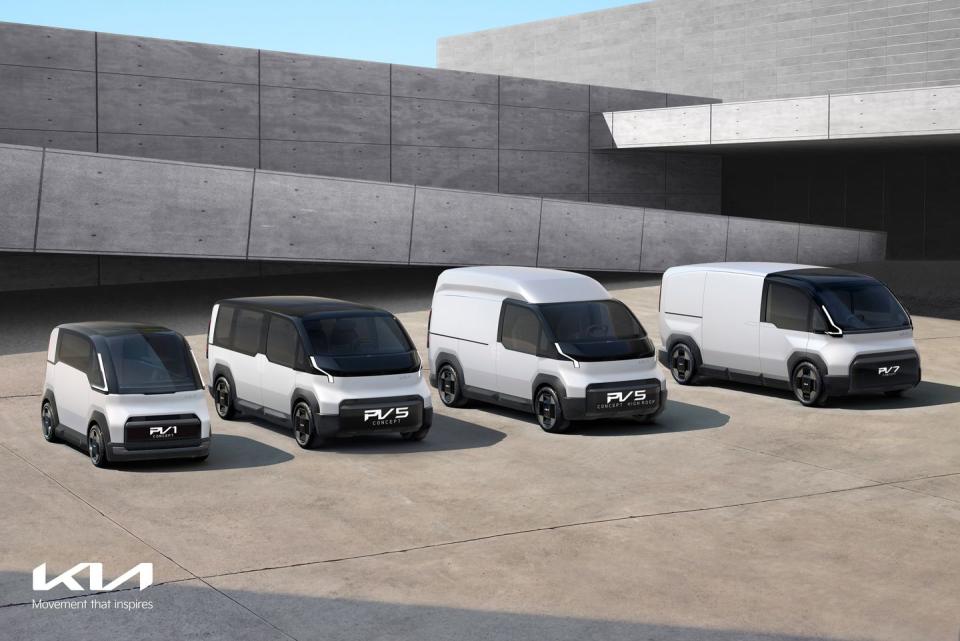-
Kia launched an ambitious plan for fleets of modular commercial electric vans at CES 2024, showing three models, some of which can be swapped out with pickup truck bodies, van bodies, or configured as people haulers.
-
Tracks mounted inside the vans allow for some of the modularity, while the rest is done by actually swapping out large sections of the vehicles’ bodies.
-
Production starts in Korea in 2025, and they may come to the US.
Kia showed off a new line of electric vans at CES, with modular, swappable bodies that can turn each of them into just about whatever you want. The three vans are grouped under the heading PBV, which stands for a few things. But the official and most common reference we heard was “Platform Beyond Vehicle.”
“(The) PBV platform offers users a blank canvas to redefine how space and mobility can adapt to their needs by providing exceptional flexibility through radical modularity,” said Kia.
Swapping major body components requires a leap of faith in engineering. We are reminded of the Nissan Pulsar. Surely there’s new technology and body mechanics to address issues like wind seals, watertightness, and the inevitable squeakiness that results when designers and body engineers haven’t really talked these things through.

The night before CES, Kia showed a full-size model of the largest of the vehicles, the PV 7, and it looked like it could haul a lot of stuff. While specific dimensions weren’t released, you could maybe compare it in size to the Ford Transit, but that’s just an eyeball guess.
The vans range in size from the big PV7, to the midsize PV5, and the diminutive PV1, the latter which was shown backing up rear-hatch-to-rear-hatch with the PV7 and swallowing a load like a baby bird eating worms. Such transfers appeared to be handled robotically, the idea being the dinky PV1 would be used for the last-mile of the delivery, in narrow confined streets that would challenge the massive PV7.
The first one of these we’re likely to see is the PV5, which will arrive in 2025, Kia said. The idea, as with all of these, is multiple uses through body swapping.
“Behind a fixed cab, or ‘driver zone,’ a variety of interchangeable upper bodies, or ‘life modules,’ can be connected to the base vehicle via a hybrid electromagnetic and mechanical coupling technology, turning the PBV into a taxi during the day, to a delivery van at night, and a personal recreational vehicle on weekends,” Kia said.
That should be reassuring to those who remember the Nissan Pulsar, or even that fixed-roof Mercedes 450 SL that you lifted off and stored via ropes and pullies above the car in your garage. Surely this technology has improved since then.
“The weldless body structure assembly is designed to enable the length of moveable members to be flexibly adjusted according to vehicle use purpose,” Kia said. “Shipped in standardized, convenient kit form, Dynamic Hybrid technology is intended to allow for the quick and simple in-field transformation of a Kia PV5.”
The first PV5s will be available in Basic, Van, High Roof, and Chassis Cab configurations, or any combination of those. A Robotaxi model will come at some future date, which Kia says can be used as “a revolutionary autonomous hailing experience,” perhaps like Waymo or Cruise.
After the PV5 arrives, next will be the PV7 and PV1. All these will be built at a new PBV-dedicated EVO plant in Autoland Hwaseong, Korea. Production starts in 2025 and while there’s no official word about US imports, we’ve heard we’ll almost certainly get them.
Do you think electric vans are a viable way to significantly grow the EV market? Please comment below.


